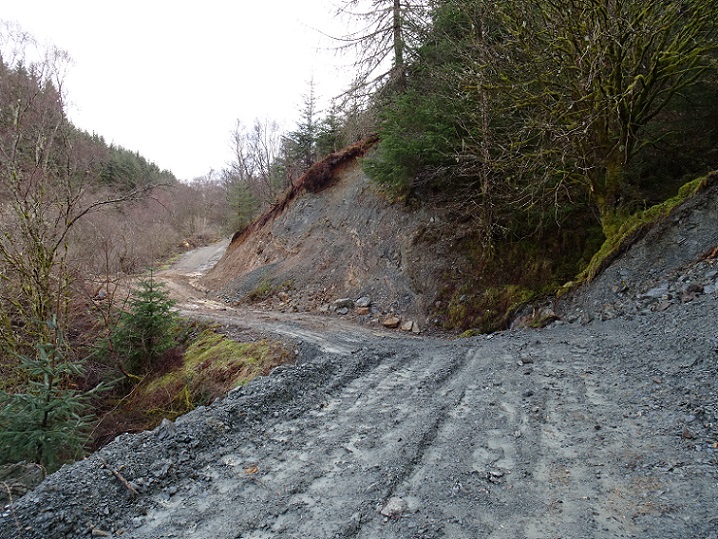
One reason I walked up the Ardchullarie path last week (see here) was that I had wanted to take a look at the state of forestry road above. I had blogged about this in March 2021 after Jane Meek had sent some horrendous photos (see here). One year on the road looks as bad as it did then and parts of it worse.
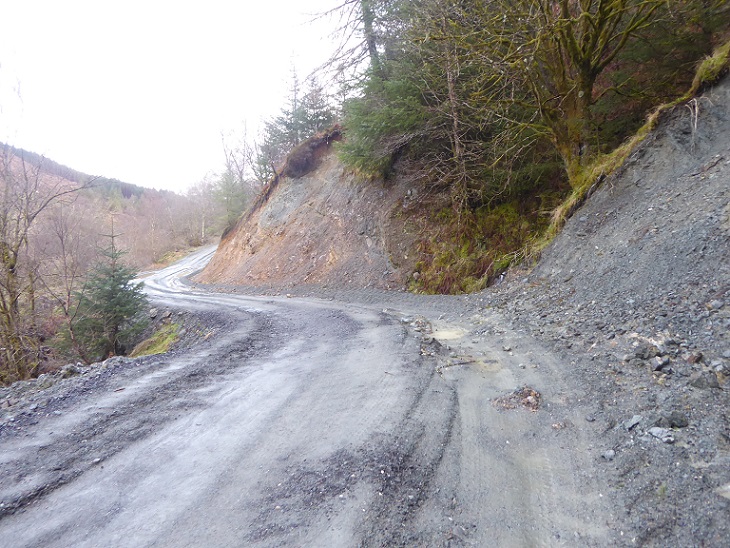
The proposals for the track consisted of two parts, an upgrade to the existing track 690m in length and the creation of a new 90m connecting spur to to the forest plantation
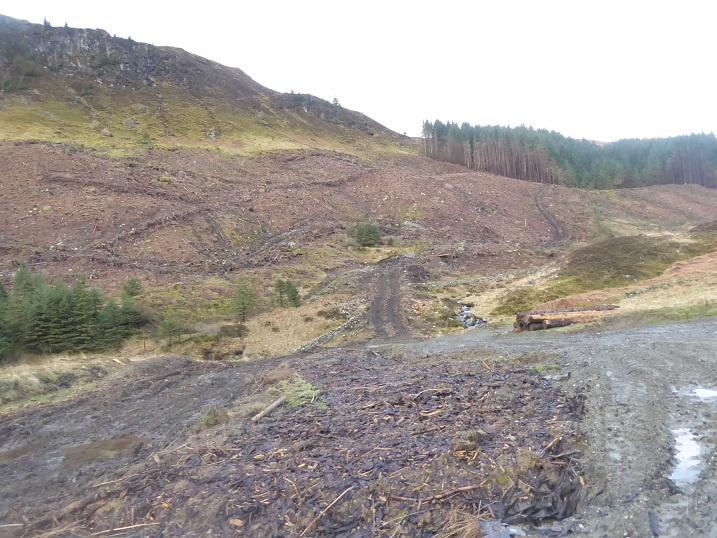
The LLTNPA did recognise the landscape impact of the proposals:
“Therefore it is important that the visual impact is minimal. It is acknowledged that there will be a visual impact during tree removal, however, it is considered that this can be lessened in the long term by removing the temporary access track [i.e. the spur] and narrowing the permanent tracks [i.e the upgraded section] after tree removal”.
As a consequence the LLTNPA imposed two planning conditions (see here for papers), the first requiring the spur to be fully restored, the second requiring the upgraded track to be narrowed in accordance with a restoration plan. This was to be agreed with the LLTNPA before the restoration work started.
According to the planning papers that restoration work was due to take place in February and March of this year. Last week there was no sign that it had started, although the felling appeared complete, and as yet no restoration plan has been published on the LLTNPA Planning Portal.
These two planning conditions, however, were fundamentally flawed:

Narrowing the track back to its previous width will in itself do little to reduce the landscape impact of the cutting that has been excavated across hillside. The main impact is caused by the width of the shelf and the over-steepened bank above. Unfortunately, there is nothing in the two planning conditions requiring these to be restored to their original state.
Has the road been constructed according to the Construction Method Statement?
There are, however, two further conditions attached to the prior approval requiring all works to be undertaken according to an agreed Construction Method Statement (CMS) and for the applicant, RDS Forestry, to submit regular monitoring reports. Below are quotes from the CMS constrasted with the situation on the ground this month:
“Roadside batters should be cut to a stable and even angle of repose free of overhangs and loose rock” (Construction Method Statement).
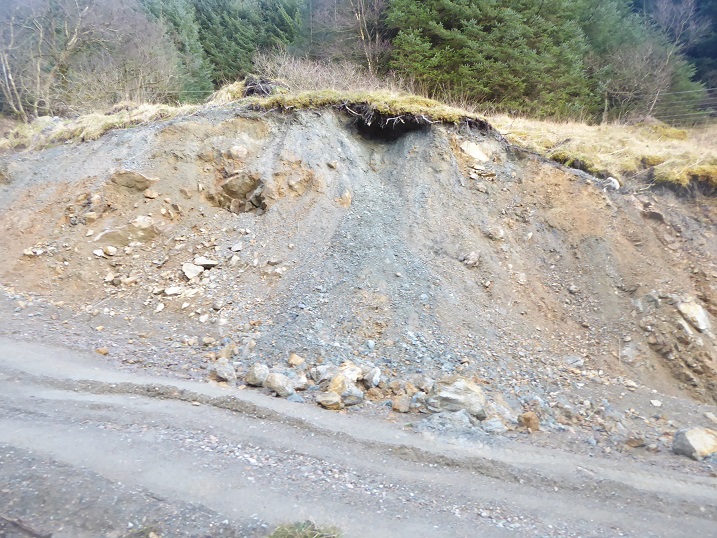
“Batters are proposed to be graded to a stable angle and feather into the original slope profile” (CMS)




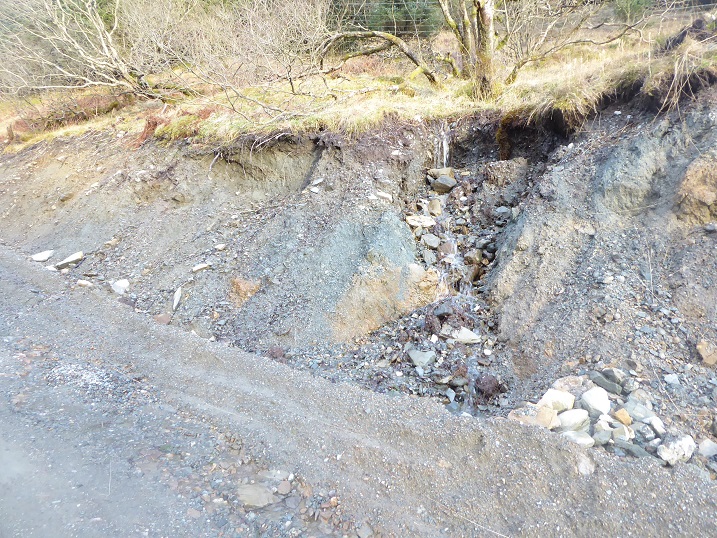
![]()
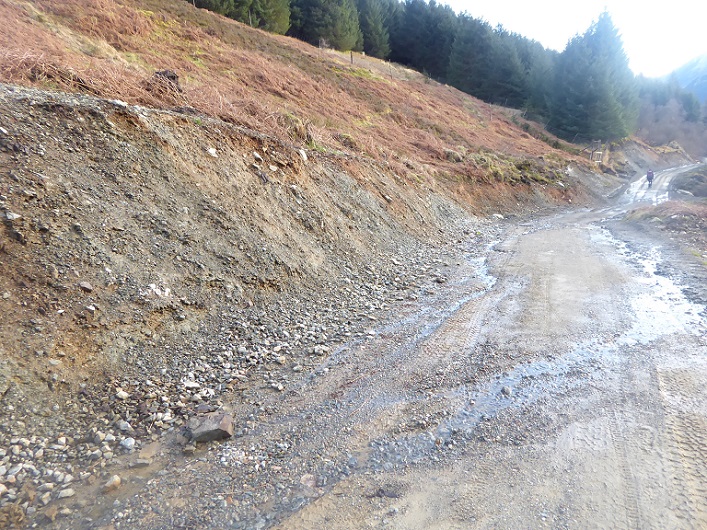
![]()
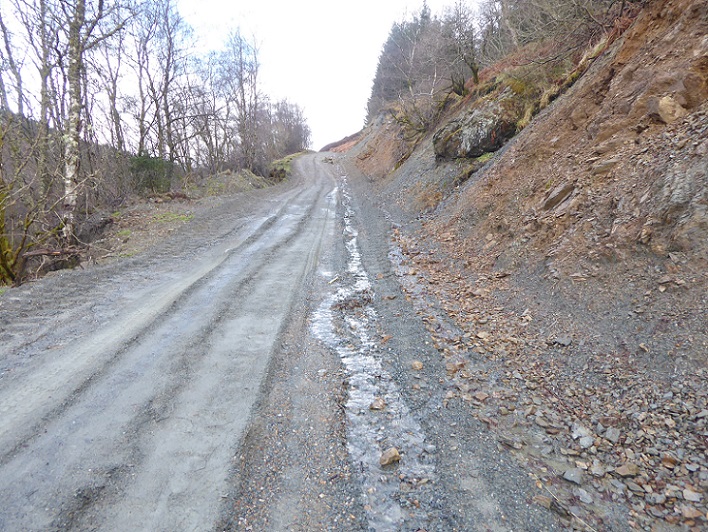

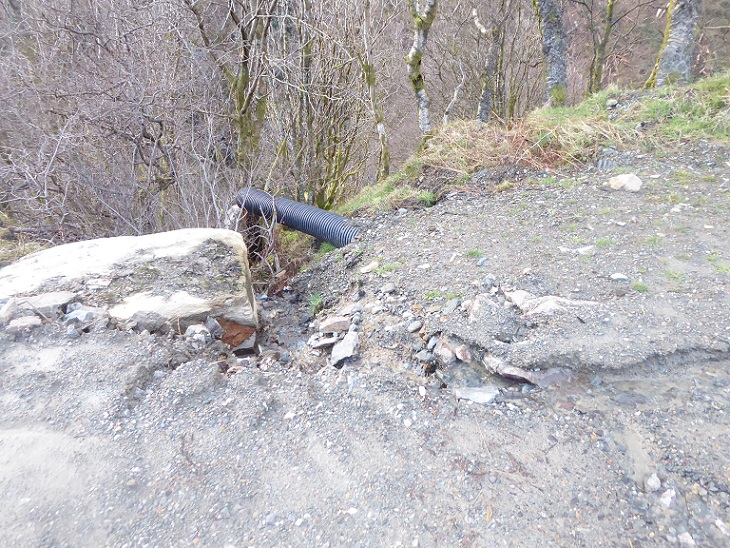
Clearly the construction method statement has not been followed. The consequences don’t just affect the landscape.
Examples of the erosion caused by poor design and construction


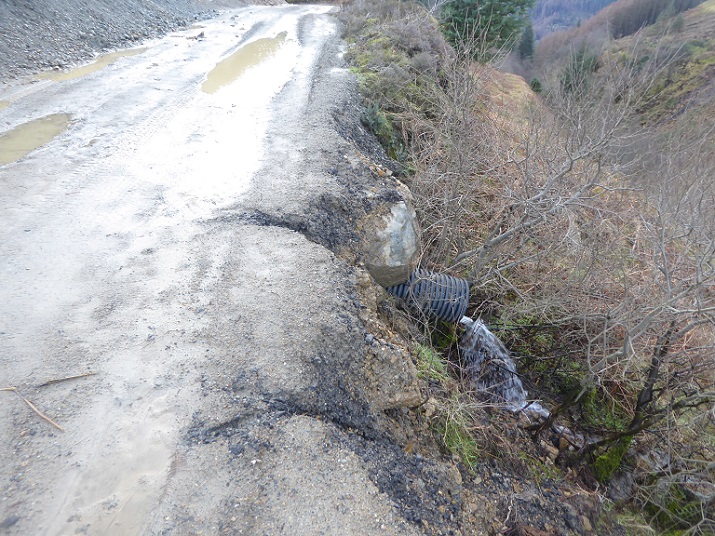
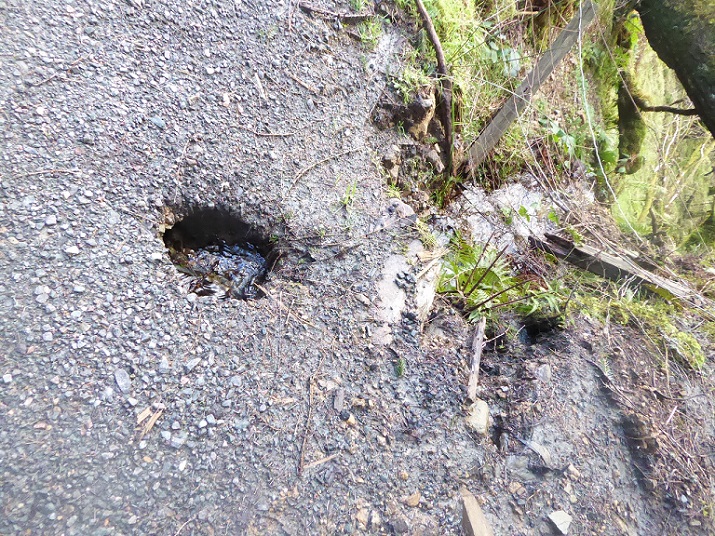
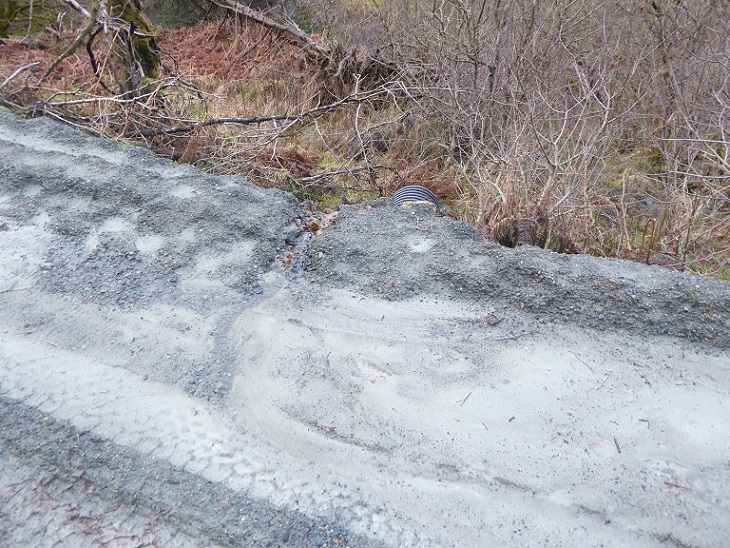
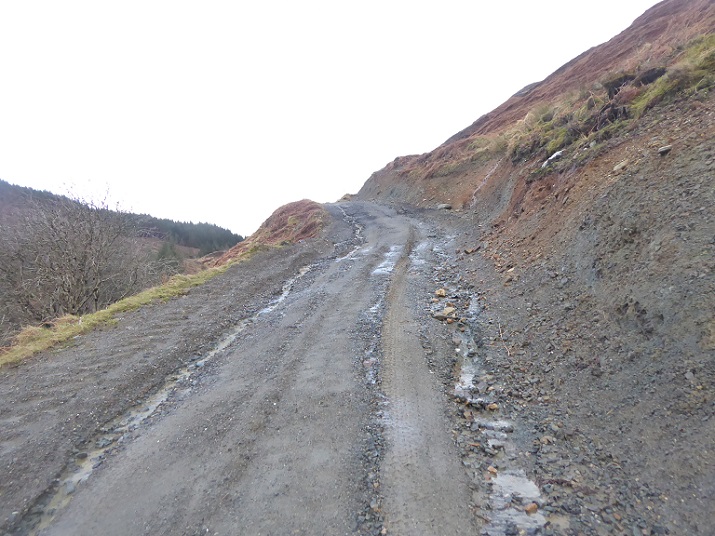
It’s not just the LLTNPA that should be concerned about this, it is also the Scottish Environment Protection Agency SEPA.
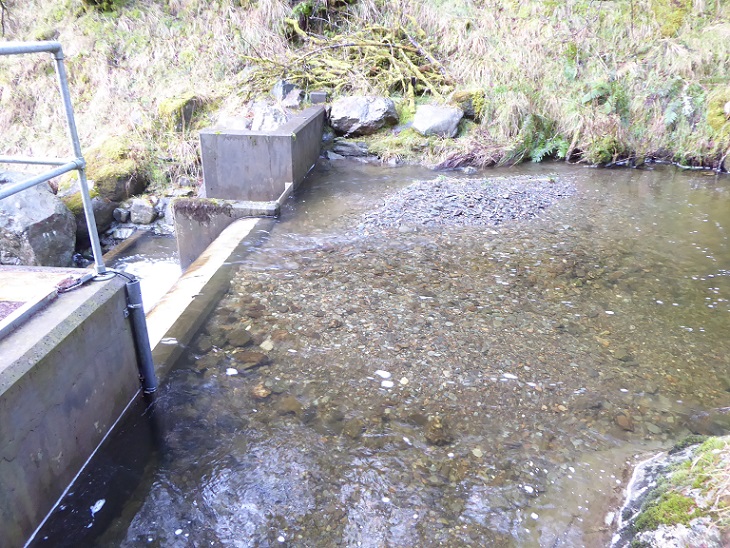
While run of river hydro intakes do gradually fill in over time, it appears that the Ardchullarie intake may be filling up quicker than one might normally expect.
How has this hill road disaster been allowed to happen?
A month after my post last March, I submitted an FOI request to the LLTNPA for a copy of Scottish Forestry’s opinion (as referred to in the officer’s report) that an Environment Impact Assessment (EIA) was not required for this road and for a copy of the monitoring reports which the developer was required to submit “within a month of the widening of the track”.
The LLTNPA responded at the end of April to say they did not have a copy of Scottish Forestry’s EIA screening opinion but did have a copy of the applicant’s request for a Screening Opinion, a very different thing. The request form included the claim that “There are no perceived environmental impacts from the development if the methodology in the supporting documentation is followed”.
What the evidence now shows is that the the road upgrade has had massive environmental impacts and not just because the methodology set out in the Construction Method Statement does not appear to have followed. The design itself appears to have been fundamentally flawed and should as a consequence been subject to a proper Environmental Impact Assessment, whether or not this was required under the current rules for forest tracks.
The LLTNPA also stated that they had not received a monitoring report, acknowledged this was late but also claimed that this was because the construction was not yet complete and the report would be sent in “imminently”. If they have received a report since they have not forwarded it to me and it’s not published on the planning portal. More FOIs beckon.
By the time, however, any monitoring reports were received it would have been too late to prevent the needless destruction. The environmental costs of trusting developers to take care are very high. Planning Officers should be sent to monitor developments from the moment they start.
What’s gone wrong and how could this have been prevented?
According to NatureScot’s Guidance on Constructed Tracks in the Uplands (see here) “Track design should, as far as possible, reflect the existing topography, making minimum use of cuttings and embankments”. Had there been a proper environment impact assessment it should have been obvious that for much of its length the 690 section of road runs across a steep slope and the only way to widen would be to excavate steep high batters. That would have shown that in only a few places would the batters be low or gentle enough to be easily restored while leaving running room for the restored track.
Given the extent of the damage caused by the excavation of new cuttings, there are some serious questions about how far restoration is now technically possible. If it is, it will require a very skilled contractor and be very costly – potentially wiping out the profits the Glen Ample estate has made from the sale of timber. If it is not, that would be a strong argument that this track upgrade should never have been allowed and alternatives considered.
No-one benefits from this disastrous situation: the LLTNPA planners will either roll over – as they did with almost all the hydro schemes – their reputation damaged even further, or they will become engaged in a protracted dispute to put matters right; the Glen Ample estate potentially faces large bills, either from contractors or lawyers defending their interests; walkers are faced with a massive eyesore; and Ardchullarie faces the prospect of having to excavate their hydro intake far more frequently than they might have done and may well decide to sue.
All these problems stem from the assumption by the forestry industry in Scotland that large vehicles are needed to extract timber. Large vehicles require wide roads, hence the current proposal to build an enormous new motorway behind Newtonmore (see here) instead of extracting timber in smaller lorries down the single track public road in Glen Banchor. The answer is simple, use smaller vehicles. Had the LLTNPA insisted on that here, most of the problems illustrated in this post could have been avoided. Our National Parks may not have the power to refuse planning permission for forestry tracks but there is nothing to stop them imposing conditions that would require much smaller lorries to be used.
Large numbers of forest plantations, like that featured here, were planted without any thought to how the timber should be extracted. Many of these plantations are now reaching maturity. It’s not just in our National Parks but across Scotland we face the prospect of an epidemic of Prior Notifications for new or upgraded forestry roads which will have a massive impact on landscape, outdoor recreation and ecology. The single most effective way to reduce that potential destruction is to use smaller vehicles. Time for our National Parks to show a lead!
Information on the use of low impact timber extraction vehicles can be found here: https://timbertransportforum.org.uk/. Such vehicles can easily be identified as they have narrow pipes visible on the outside of every wheel, so that the driver can adjust the tyre pressure on each wheel from inside the cab. The use of such vehicles should be made mandatory and built into the conditions attached to forestry grants and planning conditions for timber extraction from MOST forests in upland Scotland. This will enable timber extraction to take place along much narrower roads and prevent the construction of the ugly motorway style new forest roads that are spreading over much of our uplands at breakneck speed. We also need fundamental reform of the Scottish Government agency Scottish Forestry. It still works on principles established by the former UK Forestry Commission which was created in 1919. SF needs to be broken up so that its regulatory function is separated from its grant aid function. We need a stand alone regulatory body for forestry, rather like SEPA, rather than a forestry organisation that is both judge and jury, marking its own homework, and is continuously confusing its regulatory role with its grant aid functions. SF’s current grant aid powers should be transferred to other public bodies, such as NatureScot, Local Authorities or Community Groups as the next stage of the Scottish Government’s land reform programme.